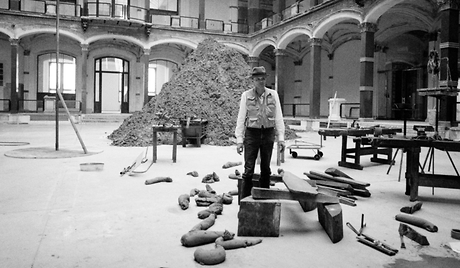Joseph Beuys: Utopia at the Stag Monuments is the most important UK exhibition of Beuys’ work in over a decade. Curated by Norman Rosenthal, who worked with Beuys on many exhibitions from 1970 onwards, the exhibition brings together pivotal works from various stages of the artist’s life. The exhibition spans the years 1947-1985 and can be seen through a retrospective lens, featuring major sculptures and rarely seen early works, which cumulatively reveal the extent to which the artist’s ideas and idiosyncratic iconography were clearly defined from the very beginning of his career. The show’s title originates from Hirschdenkmäler (Stag Monuments), the environment Beuys created for the legendary 1982 Berlin exhibition Zeitgeist, co-curated by Christos M. Joachimides and Rosenthal himself. Notably, for the first time since its creation most of the original elements of Stag Monuments, including Ofen (Oven), will be reunited in the Library Gallery at Ely House.
Joseph Beuys famously declared: every man is an artist. The statement refers to Beuys’ view of creativity as a universal principle that extended beyond traditional artistic activities into all areas of human production. Beuys believed in the revolutionary power of art to unlock the potential for creativity in everyone and, by extension, to transform society. He subscribed to an interdisciplinary concept, eliminating the barriers between art and life to create the unified concept of ‘Social Sculpture’. Beuys’ utopian vision of social transformation through individual creativity and self-determination was expressed through his art, but also through Actions, lectures and sustained political activism. These were often elucidated by Beuys on blackboard-artworks, like Ecology and Socialism, 1980, relics of the artist’s role as instructor. His ideas remain as relevant now as they were radical then and, as Rosenthal argues, ‘In a world that is now more than ever searching for new socio-economic solutions, the full significance of Beuys as an artist has barely begun to be investigated’.
For the first showing of Stag Monuments in the atrium of the Martin-Gropius-Bau in 1982, Beuys constructed a mountain of clay around which the contents from his Düsseldorf studio, including workbenches and tools, were arranged. One of the artist’s last great works before his untimely death in 1986, Stag Monuments is emblematic of many of Beuys’ fundamental concerns, uniting his belief in Social Sculpture with the powerful symbolism of animals and the reconciliation of opposing forces. Steeped in German folk tradition, the stag assumes particular meaning in Beuys’ work as a spiritual being, an ‘accompanier of the soul’ in Celtic mythology and a signifier of the crucified Christ. The stag is a conventional symbol of masculine virility, but this is united with a feminine aspect in the annual shedding of its antlers that mirrors the cyclical fertility of nature. Following the Zeitgeist exhibition, Stag Monuments metamorphosed into a related sculptural environment, Blitzschlag mit Lichtschein auf Hirsch (Lightning with Stag in its Glare), 1958-85, (currently on view at Tate Modern), which is composed from bronze casts of many, but not all, of the original elements.
| Duration | 18 April 2018 - 16 June 2018 |
| Times | Tuesday – Saturday 10 am – 6 pm |
| Cost | Free |
| Venue | Galerie Thaddaeus Ropac |
| Address | Ely House, 37 Dover Street, London, W1S 4NJ |
| Contact | 4402038138400 / polly.gaer@ropac.net / www.ropac.net |

